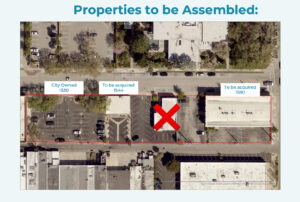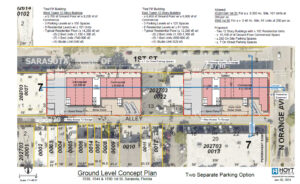The two-12 story towers across from city hall will be city-owned and -run.
By Florence Fahringer
Original Air Date: Apr. 17, 2024
Host: On Monday, the Sarasota City Commission discussed another affordable housing project. But unlike past proposals, this one came from within the city government itself. The proposal calls for the city to buy land across the street from city hall, on which two 12-story apartment towers would be built. After three hours of deliberation, the committee passed the motion. Here’s Florence Fahringer with the details.
Florence Fahringer: Of the nine-hour meeting this past Monday, this affordable housing proposal took up a third of the commissioners’ time. It was a daunting proposal, unique from the get-go: Instead of a private developer coming before the commission, proposing affordable housing with profit as their main objective, it was the city manager giving this presentation, not to increase some private entity’s revenue, but rather to directly confront the city-wide housing crisis.

On First Street, across from city hall: Two 12-story towers, separated by a credit union building, offering ground-floor retail.
Marlon Brown: Since 2009, when I came to the City of Sarasota as Deputy City Manager, we’ve spoken about affordable housing, and attainable housing, and workforce housing. We have done little. We’ve got some dribs and drabs here, by developers actually building attainable and affordable housing, but we haven’t done anything impactful; we’ve spoken about it. A crisis came about, couldn’t do anything about the crisis.
With the direction that you gave me back in March of 2023, we brought on both Ian Black and Steve Horn, and Chris Gallagher, to see what we can do to make an impact, where we can provide housing for our workforce. We came up with a proposal that can probably accommodate almost 400 workforce individuals, right in the heart of downtown.
FF: The proposal calls for the city to purchase land on First Street, just opposite City Hall; that’s the actionable part of the plan, which the commission would vote on later in the meeting. Beyond that, the project would then have the city use that land to construct two towers, twelve stories high, with a first floor dedicated to commercial activity, and a few floors for parking. The remaining floors would be used for housing, and all of that housing would be classified as “attainable.”
MB: If you recall from our discussion about the bonus density, 15% of the bonus units have to meet the 80% below, 80–100, and then 100–120. That equates to about 22 units. Again, eight of them will be below 80, seven will be 80–100, and then seven between 100–120. But because we are doing all attainable, the rest of the units, the additional 122, including the 48 — again, all depends on the commission, between 80–120 or however the commission wants to distribute them.
FF: Public commenters were a mixed bag of yay’s and nay’s. The first few speakers minced no words in their contempt for the project, commenter Martin Hyde summarizing their complaints:
Martin Hyde: Let’s put it in terms everybody can understand: $78,000 is the lowest level, the level of which you get the maximum subsidy. I don’t know how many people in this room make $78,000 a year or above, but I guarantee it’s not all of them, and I guarantee they are all housed. […] There is no plan other than to use other people’s money. You’ll do it, you always do do it, absolutely you’ll do it. It’s social engineering; It’s socialist engineering. […] Don’t give a handout to yuppies.

Ground-floor retail is part of the plan.
FF: They were followed by some more positive voices. Notably, one of those positive voices belonged to John Harney, a representative from the Suncoast Partnership to End Homelessness.
John Harney: I’m very much in favor of this project. I would like to speak first to the “people” part of this. There was a remark made earlier where there is a development for yuppies. The figures are pretty high; if you look at 80% of AMI, yes, that is more than a typical worker is making in the county. The typical problem that happens in communities like Sarasota County and many other counties is that AMI number is also based on passive income. It’s not work income. It’s based on passive income that tends to skew the numbers much higher.
I suggest consideration be made to make some of these apartments available for people up to 60% AMI. That lower end covers a lot of the workers that you’re talking about previously. City employees, county employees, hospital workers, police and fire, teachers, they would fall below that 80% number; they would not be able to afford that 80%. If you want to truly include this part of our population, that 60% number will include many of them.
FF: Later, during commissioner comments, Erik Arroyo made a point to address the 60% AMI suggestion directly. He rejected the idea of lowering the threshold, suggesting that public housing takes care of low-income families.
Erik Arroyo: Somebody mentioned 60% of AMI. There is a name for that category of anything under 60% of AMI, it’s Section 8 Housing. That’s not what we’re building here. We’re building workforce housing for working class people.
FF: Otherwise, when it came to the project as proposed, with 80% AMI as the lowest income threshold rather than 60%, the commissioners all had good things to say. When it came to a vote, the motion passed unanimously.
This is Florence Fahringer, reporting for WSLR News.
WSLR News aims to keep the local community informed with our 1/2 hour local news show, quarterly newspaper and social media feeds. The local news broadcast airs on Wednesdays and Fridays at 6pm.